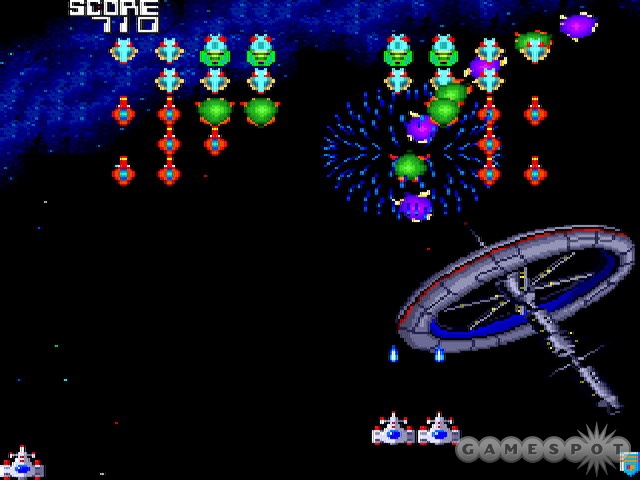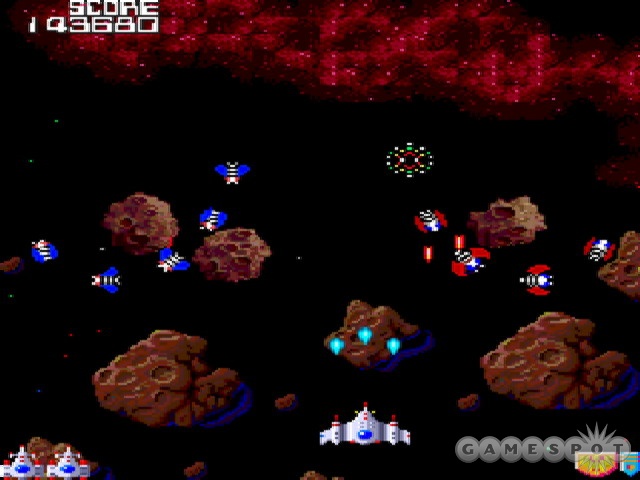Now that the TurboGrafx-16 version of Galaga '90 has been added to the Virtual Console shop, you may be wondering what relationship the game shares with the NES version of Galaga that has been available in the shop for a while now. In a nutshell, the NES rendition of Galaga was a port of the original 1981 arcade game, whereas Galaga '90 is a sequel that modestly builds on the original formula with a larger menagerie of enemies, the ability to warp to new dimensions, and all-around snazzier visuals.

Galaga '90, like Galaga, is a fixed shooter-style game. You move your ship left or right on a little strip at the bottom of the screen while numerous enemies fly in from all directions, collect in a mass up at the top, and then swoop down to attack your ship in various formations. You earn points for shooting enemy ships, you lose a ship if you get hit by bullets or enemies, and you move on to the next stage once you shoot down all of the enemies in the current stage. Enemies attack in predictable formations, just like they did in Galaga, but this game features a wider range of enemy ships that are more likely to launch a cluster of missiles or split into multiple tiny ships during their attack runs.
Namco didn't make any major changes to the classic Galaga formula. Instead, they incorporated a slew of minor variations that make this sequel more intense than the original, while still retaining the first game's spirit. Along with expanding the list of enemies, they included 29 brand-new stages to beat. As in the original, most are fixed screens. However, some are scrolling stages that culminate in a boss battle. Interstellar obstacles such as asteroids and attack satellites also occasionally come into play. You can still create a double-ship by letting your ship get captured and then rescuing it, but now you can also do the same with your double-ship to create a giant ship with triple the firepower. If you want, you can begin the game with the double-ship formation, though you'll immediately sacrifice a life to do so. Lastly, you can now collect stones that give you the chance to warp to new dimensions after completing bonus stages. In this fashion, there are five different dimensions to see and five different final bosses to challenge.
The game also retains the look and feel of the original Galaga, but there are now planets and space stations decorating the star fields, and different musical fanfares play in every stage. There are more enemies to see, they're more colorful, and they unleash a wider variety of bullets and missiles. Quite often, enemies will explode in a dazzling display of fireworks. Of course, since the game tries hard to maintain the classic Galaga feel, the ships are still generally tiny and the backdrops are still primarily static scenes.

Starting out with a double-ship right from the beginning lets you tear into enemies from the get-go. The original Galaga was at times conservative in its bluster, whereas the exchange of gunfire between you and the multitude of enemy ships in this game is nearly constant. The frequent explosions of fireworks also ratchet up the excitement level. However, Galaga '90 is still Galaga at heart, and all of the modest improvements probably won't be enough to make you like the game if you didn't find the original enjoyable. The game is also far behind the curve compared to the majority of shoot-'em-ups that came out in the late 1980s. Other games introduced things like massive boss ships, cluster bombs, and realistic scrolling backdrops. Galaga '90 retained the fixed backgrounds, lifeless star fields, and mundane machine guns that its predecessors had.
For better or for worse, Galaga '90 is a souped-up Galaga. It's a space shooter with early-1980s sensibilities and some late-1980s flair. If you're into that sort of juxtaposition, you'll consider the 600 Wii points ($6) it'll cost you to play the TurboGrafx-16 rendition of the game a bargain.